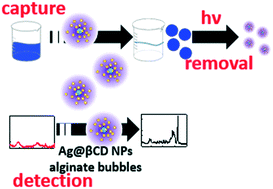Plasmonic hydrogels for capture, detection and removal of organic pollutants†
Abstract
Ensuring high quality of water is an urgent challenge for today's research. In spite of the enormous progress achieved in the area, the quest for all-in-one systems able to adsorb, detect and degrade pollutants has not been sufficiently accomplished. Here, we present multi-functional plasmonic hydrogels composed of β-cyclodextrin-functionalized silver nanoparticles (Ag NPs) embedded within bubbles made of alginate. The synergistic combination of individual building blocks enables multi-purpose systems to be obtained: the alginate matrix ensures good adsorption properties, β-cyclodextrins (βCD) act as molecular receptors and Ag NPs enable the pollutant detection through surface enhanced Raman spectroscopy (SERS) and its plasmon-assisted photo-degradation. Their activity has been tested during the capture, detection and photodegradation of methylene blue and sulfamethoxazole, but the general affinity of βCD receptors towards benzene and heterocyclic rings makes these nanocomposite hydrogels extremely versatile scavengers for most of the common organic pollutants, including biphenyls, other dyes and pharmaceutical compounds. In addition, their stability, ease of manipulation, dispersion and recovery make these systems ideal for both in situ and ex situ applications, enabling water-treatment under real conditions.



 Please wait while we load your content...
Please wait while we load your content...